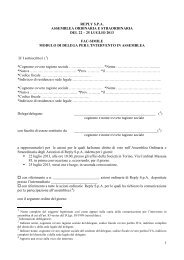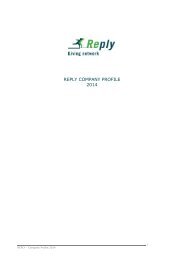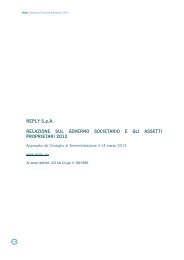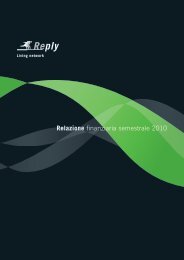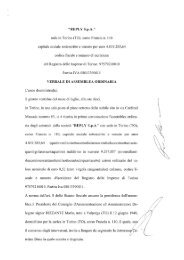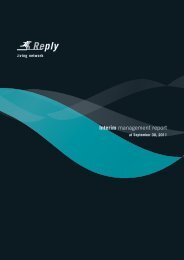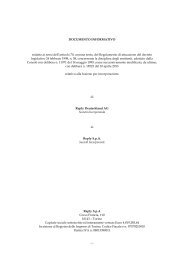Reply SpA
Reply SpA
Reply SpA
Create successful ePaper yourself
Turn your PDF publications into a flip-book with our unique Google optimized e-Paper software.
Consolidated financial statements as at December 31, 2010<br />
Currency risk<br />
<strong>Reply</strong> S.p.A. has a limited exposure to exchange rate risk, therefore the company does not deem necessary hedging<br />
exchange rates.<br />
Interest rate risk<br />
<strong>Reply</strong> S.p.A. makes use of external funds obtained in the form of financing and invest in monetary and financial<br />
market instruments. Changes in market interest rates can affect the cost of the various forms of financing, including<br />
the sale of receivables, or the return on investments, and the employment of funds, causing an impact on the level of<br />
net financial expenses incurred by the company.<br />
In order to manage these risks, the <strong>Reply</strong> S.p.A uses interest rate derivative financial instruments, mainly interest<br />
rate swaps with the object of mitigating, under economically acceptable conditions, the potential variability of interest<br />
rates on the net result.<br />
Sensitivity analysis<br />
In assessing the potential impact of changes in interest rates, the company separates fixed rate financial instruments<br />
(for which the impact is assessed in terms of fair value) from floating rate financial instruments (for which the impact<br />
is assessed in terms of cash flows).<br />
Floating rate financial instruments include principally cash and cash equivalents and part of debt.<br />
A hypothetical, unfavorable and instantaneous change of 50 basis points in short-term interest rates at December<br />
31, 2010 applied to floating rate financial assets and liabilities, operations for the sale of receivables and derivatives<br />
financial instruments, would have caused increased net expenses before taxes, on an annual basis, of approximately<br />
11 thousand Euros (63 thousand Euros at December 31, 2009).<br />
This analysis is based on the assumption that there is a general and instantaneous change of 50 basis points in interest<br />
rates across homogeneous categories. A homogeneous category is defined on the basis of the currency in which<br />
the financial assets and liabilities are denominated.<br />
To determine the effect of interest rate derivate financial instruments <strong>Reply</strong> refers to evaluation deriving from third<br />
parties (banks and financial institutes) who base their estimates on direct (interest rates) or indirect observation of<br />
the market: consequently the fair value used by the Group in accordance to the IFRS 7 for derivative hedge contracts<br />
is classified as a hierarchy of Level 2 (prices not available on active markets for the assets or liabilities being measured<br />
but can be directly or indirectly observed).<br />
The market value of the Interest Rate Swaps represents the present value of the difference between fixed interest<br />
rates to pay and or to receive and the interests evaluated on the market having the same expiry date as the derivative<br />
contracts.<br />
The Interest Rate Swap leads are can lead to the exchange of interest flows calculated on the nominal value of the<br />
derivative at a fixed or floating rate at the fixed expiry date agreed by the parties. The nominal value does not represent<br />
the amount exchanged by the parties and therefore does not constitute the credit risk exposure, that is limited<br />
to the difference between the interest that has to be exchanged at expiry.<br />
118



